Top reason US consumers snack is to treat themselves
While consumers may be growing more health-conscious with their food choices, it seems there is still room for life’s little indulgences. New research on snacking motivations from Mintel reveals that the top reason Americans say they snack is to treat themselves (50 percent) and more than one quarter (28 percent) agree that taste is more important than health when choosing a snack.
37% of consumers say they snack to give themselves a break during the day
In addition to rewarding one’s self, snacking for self-care continues to be a popular motivator as nearly two in five (37 percent) consumers say they snack to give themselves a break during the day and 24 percent snack to relieve stress. What’s more, one in six (17 percent) Americans snack today in order to control their weight, up from just 10 percent who said they snack to help them lose weight in 2015.
Despite the propensity to indulge, health plays a key role in the types of snacks consumers eat. One third (32 percent) of consumers say the majority of snacks they eat are healthy and over one quarter (28 percent) say they are snacking on healthier foods this year than in 2016. In fact, snacks with health-related claims are among the fastest growing snack launches, with low/no/reduced allergen claims accounting for 46 percent of total new snack product launches in the US in 2017, an increase of 30 percent over 2013, according to Mintel Global New Products Database (GNPD).
While the percentage of Americans who say they snack has remained steady in recent years*, snack frequency is on the rise as those who say they snack two to three times per day increased from 50 percent in 2015 to 55 percent in 2017, while those who report snacking once per day decreased to from 29 percent to 24 percent over the same time period.
Not surprising, younger consumers are leading the snacking revolution as Millennials (aged 23-40) are the most likely to snack four or more times per day (25 percent), compared to just 10 percent of Generation X consumers (aged 41-52) and nine percent of those in the Baby Boomer generation (aged 53-71).
“The importance of snacking in America is undeniable and it is creating more and more opportunity for companies and brands as snacking frequency increases, particularly among younger consumers. While health is a factor for consideration in food and drink decisions, the majority of snackers do so for a treat, meaning even health-focused snacks should appeal with messages about enjoyment and indulgence. In recent years, brands have focused product innovation largely on cleaner formulations, highlighting an opportunity for innovative products with health attributes that appeal to health-conscious consumers,” said Beth Bloom, Associate Director of US Food and Drink Reports at Mintel.
Mintel research indicates that time of day has a strong impact on what consumers turn to for a snack. Snackers appear to be interested in starting the day on a high note, looking for snacks that are healthy (29 percent), light (23 percent) and energizing (23 percent), while sweet (30 percent), comforting (25 percent) and indulgent (22 percent) snacks are more sought after in the evening. When it comes to an afternoon pick-me-up, consumers are most likely to look for snacks that are healthy (26 percent), sweet (23 percent) and energizing (22 percent). This is also the time of day consumers are most likely to reach for a beverage as a snack, including 15 percent of snacking Americans, compared to 12 percent who say the same for the morning and 11 percent in the evening.
2 in 5 consumers agree that anything can be considered
a snack
It seems opinions of what constitutes a snack are expanding as nearly two in five (38 percent) consumers agree that anything can be considered a snack and one in seven (14 percent) say they are snacking on ‘less traditional’ snack foods, such as sandwiches and cereal.
“Capitalizing on the snack craze goes beyond the traditional food categories that are commonly recognized for snacking,” continued Bloom. “One snack type does not necessarily fit all, highlighting an opportunity for brands to grow adoption in the snack market by creating products that align with the differing snack preferences throughout the day, as well as by positioning products as a good choice for snacking.”
When it comes to salty indulgences in particular, Mintel’s report on salty snacks reveals that the types of salty snacks** consumers eat depends on the occasion. While consumers are most likely to enjoy popcorn while watching TV or a movie at home (62 percent), the various types of popcorn available, such as caramel corn or microwavable, make it versatile as a snack for when consumers want to treat themselves (37 percent) or want something healthy (19 percent).
Meat snacks, on the other hand, are unique due to their functionality, as they are most likely to be eaten to satisfy hunger (43 percent), provide energy (26 percent), to eat on-the-go (35 percent) or to have something healthy (21 percent).
Overall, sales of salty snacks have grown 30 percent since 2011, reaching an estimated $11.2 billion in 2016, with growth primarily driven by innovation in the meat snacks and popcorn categories. Sales of meat snacks reached an estimated $3.3 billion in 2016, up 51 percent from 2011, while sales of popcorn increased by 39 percent to reach $2.4 billion.
“Despite competition from other snack foods, the salty snack market continues to grow at a steady rate. The functional benefits of meat snacks and the convenience and health halo of ready-to-eat (RTE) popcorn are driving strong growth in each category; however, this success is also due to increased flavor and format innovation. Brands are demonstrating that popcorn can be a platform for any type of flavor, with sweet flavors gaining popularity, while meat snacks are going premium and artisan,” concluded Caleb Bryant, Senior Foodservice Analyst at Mintel.
To learn more about The State of Snacking: What’s Happening in Foodservice and Retail, join Mintel’s expert food and drink analysts for a webinar on Tuesday, June 20th, 12pm PT/2pm CT/3pm ET. Register here.
*94 percent snack daily in 2017 vs 94 percent in 2015
**Salty snack options include meat snacks, pretzels, corn snacks, pork rinds, popcorn and cheese-flavored snacks
Press copies of Mintel’s Snacking Motivations and Attitudes US 2017 and Salty Snacks US 2017 reports, as well as interviews with Beth Bloom, Associate Director of US Food and Drink Reports, and Caleb Bryant, Senior Foodservice Analyst, are available on request from the press office.
For the latest in consumer and industry news, top trends and market perspectives, stay tuned to Mintel News featuring commentary from Mintel’s team of global category analysts.
-
Mintel StoreGet smart fast with our exclusive market research reports, delivering the latest data, innovation, trends and strategic recommendations....View reports
-
Mintel LeapMintel Leap is a revolutionary new AI-powered platform that will transform your research process....Book a demo







































